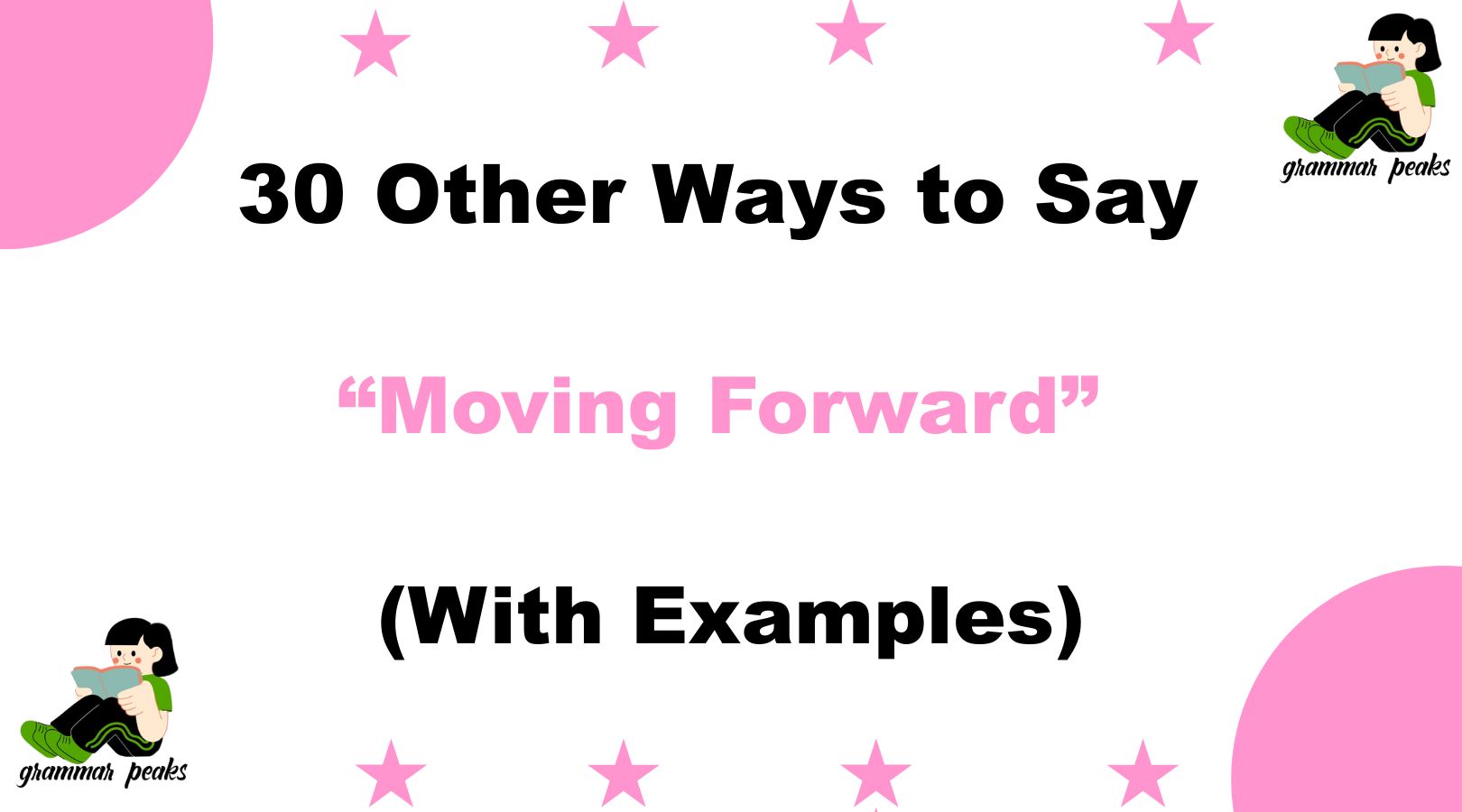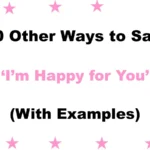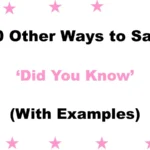Choosing the right words when talking about next steps is key to keeping conversations clear and forward-thinking. Whether you’re writing an email, giving a presentation, or outlining a project plan, saying “moving forward” too often can sound repetitive or vague.
That’s why having a variety of fresh, professional, and thoughtful alternatives helps you sound more confident, strategic, and polished. This guide covers 30 unique ways to say “moving forward” with examples, tone suggestions, and best/worst use cases to fit your communication style and context.
What Does “Moving Forward” Mean?
The phrase “moving forward” is commonly used to indicate progress, a shift in focus, or the next steps in a process. It suggests leaving the past behind and concentrating on what comes next—whether in a conversation, a business plan, or a personal situation. Often heard in professional settings, it signals a desire to take action, solve a problem, or improve upon a situation. For example, in a meeting, someone might say, “Moving forward, let’s establish clearer deadlines,” to emphasise future improvements. In essence, “moving forward” conveys momentum, growth, and a proactive mindset.
When to Use “Moving Forward”
You can use “moving forward” in meetings, emails, or plans when you want to:
- Shift attention from the past to the future
- Provide direction or instructions
- Focus on growth, resolution, or action
- Outline improvements or next phases
Is It Professional or Polite to Say “Moving Forward”?
Yes, “moving forward” is widely accepted in business, academic, and formal contexts. It’s polite, neutral, and future-focused—but it can become overused or feel robotic if repeated too often. That’s where synonyms and more expressive alternatives come in.
Pros and Cons of Saying “Moving Forward”
Pros:
- Clear and professional
- Encourages future thinking
- Helps shift from past problems to future actions
Cons:
- Can sound vague or corporate-speak
- Overused in business communication
- May come off as dismissive if used in emotionally sensitive conversations
Synonym For “Moving Forward”
- Going Forward
- From Here On
- Looking Ahead
- In the Future
- Onward
- The Next Step
- Progressing
- From This Point Forward
- What Lies Ahead
- Continuing Ahead
- As Things Progress
- Going Onward
- In the Days Ahead
- Into the Future
- From This Point On
- Going Ahead
- Starting Now
- As We Advance
- With the Next Steps
- Proceeding Ahead
- Advancing Forward
- Looking to What’s Next
- What Comes Next
- From This Moment Forward
- Toward the Future
- Let’s Continue With
- As the Next Chapter Begins
- Evolving Forward
- Charting the Path Ahead
- Steering Into the Future
1. From Here On Out
Definition: Starting at this point and continuing into the future.
Detailed Explanation: Emphasizes a clear turning point in process, behavior, or expectations.
Scenario Example: “From here on out, all updates will be shared via the shared drive.”
Best Use: When making procedural or behavioral changes.
Worst Use: When tone needs to be soft or indirect.
Tone: Assertive, direct.
2. Going Forward
Definition: Continuing in the direction of progress or change.
Detailed Explanation: A slightly more casual twin of “moving forward.”
Scenario Example: “Going forward, let’s include a short summary at the top of each report.”
Best Use: Emails, team syncs, or presentations.
Worst Use: Redundant if already using “moving forward” elsewhere.
Tone: Neutral, professional.
3. In the Future
Definition: Referring to a time beyond the present.
Detailed Explanation: Broad and flexible, ideal for setting long-term expectations.
Scenario Example: “In the future, we should budget extra time for review.”
Best Use: Feedback, lessons learned, or planning.
Worst Use: When immediate action is needed.
Tone: Reflective, formal.
4. As We Progress
Definition: While continuing along the current path or project.
Detailed Explanation: Good for ongoing efforts and iterative updates.
Scenario Example: “As we progress through the implementation phase, let’s meet weekly.”
Best Use: Long-term projects or change management.
Worst Use: Sudden or immediate shifts.
Tone: Collaborative, strategic.
5. Looking Ahead
Definition: Planning or thinking about what comes next.
Detailed Explanation: Positive and visionary, good for setting tone or roadmap.
Scenario Example: “Looking ahead, we aim to expand our customer base by 20%.”
Best Use: Presentations, vision planning.
Worst Use: When discussing immediate corrective steps.
Tone: Optimistic, forward-thinking.
6. In the Coming Days
Definition: Soon, over the near-term future.
Detailed Explanation: Implies an action or update will happen shortly.
Scenario Example: “In the coming days, we’ll circulate the finalized report.”
Best Use: Action-based emails, timeline setting.
Worst Use: For long-term strategy.
Tone: Short-term, time-sensitive.
7. In the Next Phase
Definition: As we move to the following stage of a process.
Detailed Explanation: Helpful for structured plans, like project management or campaigns.
Scenario Example: “In the next phase, we’ll focus on user testing and feedback.”
Best Use: Process-oriented discussions.
Worst Use: General future references without a clear phase.
Tone: Technical, organized.
8. As We Move Ahead
Definition: While continuing forward together.
Detailed Explanation: Emphasizes collaboration and momentum.
Scenario Example: “As we move ahead, let’s prioritize transparent communication.”
Best Use: Team communications, leadership updates.
Worst Use: Solo performance commentary.
Tone: Encouraging, united.
9. As a Next Step
Definition: The immediate following action.
Detailed Explanation: Provides clarity and structure, perfect for task delegation.
Scenario Example: “As a next step, please schedule a follow-up with the client.”
Best Use: Task-focused, decision-making.
Worst Use: High-level vision statements.
Tone: Practical, action-oriented.
10. Onward
Definition: To continue toward progress.
Detailed Explanation: Short and motivational, great for wrapping up or rallying.
Scenario Example: “Onward—we’ll regroup next week with final results.”
Best Use: Speeches, emails, closings.
Worst Use: If more detail or instruction is needed.
Tone: Bold, inspiring.
11. As Things Progress
Definition: As developments continue over time.
Detailed Explanation: Suggests continuous monitoring and adjustment during an ongoing process.
Scenario Example: “As things progress, we’ll revisit the strategy if needed.”
Best Use: Project tracking or evolving situations.
Worst Use: For announcing immediate next steps.
Tone: Adaptive, observant.
12. Going Onward
Definition: Continuing into the next stage or direction.
Detailed Explanation: Formal and slightly literary, useful in thoughtful messaging.
Scenario Example: “Going onward, we must stay aligned with our core values.”
Best Use: Company announcements, motivational contexts.
Worst Use: Daily or technical updates.
Tone: Inspirational, formal.
13. In the Days Ahead
Definition: In the near future.
Detailed Explanation: Sets short-term expectations with a calm tone.
Scenario Example: “In the days ahead, you’ll receive updated materials.”
Best Use: Event planning, short-term scheduling.
Worst Use: Long-range strategy or big-picture changes.
Tone: Reassuring, gentle.
14. Into the Future
Definition: Continuing beyond the present time.
Detailed Explanation: More visionary and broad in its meaning.
Scenario Example: “Into the future, we’ll continue investing in innovation.”
Best Use: Long-term goals or brand vision.
Worst Use: Tactical or immediate items.
Tone: Strategic, inspirational.
15. From This Point On
Definition: Starting now and continuing forward.
Detailed Explanation: Strong and clear boundary-setting phrase.
Scenario Example: “From this point on, client updates must go through the portal.”
Best Use: Policy changes, accountability communication.
Worst Use: Emotional or personal discussions.
Tone: Firm, directive.
16. Going Ahead
Definition: Proceeding from now into the future.
Detailed Explanation: Casual variation of “moving forward,” often used in spoken communication.
Scenario Example: “Going ahead, let’s streamline approvals to save time.”
Best Use: Internal team conversations or notes.
Worst Use: High-level or client-facing documents.
Tone: Conversational, informal.
17. Starting Now
Definition: Immediately beginning a new approach.
Detailed Explanation: Puts emphasis on instant change or action.
Scenario Example: “Starting now, we’ll be using the updated invoice format.”
Best Use: Operational updates or immediate rollouts.
Worst Use: For conceptual or distant-future ideas.
Tone: Urgent, authoritative.
18. As We Advance
Definition: As we continue developing or improving.
Detailed Explanation: Suggests thoughtful, upward progress.
Scenario Example: “As we advance in our digital transformation, security remains a priority.”
Best Use: Strategic progress reports or growth plans.
Worst Use: Basic task delegation.
Tone: Elevated, forward-looking.
19. With the Next Steps
Definition: As part of what’s coming next.
Detailed Explanation: Clearly implies a sequence of actions or items.
Scenario Example: “With the next steps, we’ll gather stakeholder feedback.”
Best Use: Task management or meeting recaps.
Worst Use: Visionary messaging or general planning.
Tone: Practical, structured.
20. Proceeding Ahead
Definition: Moving onward with something.
Detailed Explanation: Slightly more formal or technical version of “going forward.”
Scenario Example: “Proceeding ahead, we’ll reallocate resources to meet the deadline.”
Best Use: Proposals, formal project updates.
Worst Use: Conversational writing or light messaging.
Tone: Formal, process-focused.
21. Advancing Forward
Definition: Making forward progress.
Detailed Explanation: Doubly emphasizes momentum and growth.
Scenario Example: “Advancing forward, our focus is on client satisfaction.”
Best Use: Progress statements or leadership messaging.
Worst Use: Too wordy for tight emails or instructions.
Tone: Motivational, formal.
22. Looking to What’s Next
Definition: Turning attention to the upcoming phase.
Detailed Explanation: More open-ended and conversational.
Scenario Example: “Looking to what’s next, we’ll begin the launch phase.”
Best Use: Informal meetings or wrap-up discussions.
Worst Use: Precise planning or strategic directives.
Tone: Curious, flexible.
23. What Comes Next
Definition: The next expected action or phase.
Detailed Explanation: Encourages focus on immediate future without sounding robotic.
Scenario Example: “As for what comes next, the team will begin onboarding.”
Best Use: Guiding others without sounding forceful.
Worst Use: Official documents or formal proposals.
Tone: Friendly, transitional.
24. From This Moment Forward
Definition: A turning point with lasting future impact.
Detailed Explanation: Formal and dramatic, best used when emphasizing a decision or shift.
Scenario Example: “From this moment forward, we will prioritize integrity above all.”
Best Use: Leadership or mission statements.
Worst Use: Casual emails.
Tone: Weighty, declarative.
25. Toward the Future
Definition: In a direction of ongoing development.
Detailed Explanation: Emphasizes progress and vision.
Scenario Example: “Toward the future, our strategies must stay adaptable.”
Best Use: Inspirational contexts or change initiatives.
Worst Use: Operational updates.
Tone: Hopeful, visionary.
26. Let’s Continue With
Definition: Resuming or maintaining forward motion.
Detailed Explanation: Great for moving from one phase to another during meetings or tasks.
Scenario Example: “Let’s continue with reviewing the budget proposals.”
Best Use: Team syncs or structured meetings.
Worst Use: Vision-setting statements.
Tone: Collaborative, smooth.
27. As the Next Chapter Begins
Definition: Beginning a new phase or period.
Detailed Explanation: Evokes narrative, helpful for big changes.
Scenario Example: “As the next chapter begins, we welcome new leadership.”
Best Use: Major transitions, leadership messages.
Worst Use: Everyday internal communication.
Tone: Poetic, formal.
28. Evolving Forward
Definition: Progressing through growth or transformation.
Detailed Explanation: Ideal for innovation and change-oriented discussions.
Scenario Example: “Evolving forward, our solutions must reflect user needs.”
Best Use: Innovation-focused communication.
Worst Use: Static or routine operations.
Tone: Modern, adaptive.
29. Charting the Path Ahead
Definition: Planning and guiding future actions.
Detailed Explanation: Suggests a deliberate, strategic direction.
Scenario Example: “We’re charting the path ahead with new partnerships.”
Best Use: Executive summaries, strategic updates.
Worst Use: Fast-moving updates or tactical steps.
Tone: Executive, strategic.
30. Steering Into the Future
Definition: Actively guiding progress in a desired direction.
Detailed Explanation: Combines control with ambition—great for leadership messaging.
Scenario Example: “We’re steering into the future with renewed purpose.”
Best Use: Branding, company vision, or keynote addresses.
Worst Use: Task-level conversations.
Tone: Commanding, visionary.
Conclusion
Finding the right words to express progress and transition is essential—especially in professional, project-based, or visionary communication. While “moving forward” is a widely accepted phrase, overusing it can come off as generic or uninspired. Fortunately, this list of 30 alternatives offers a mix of formal, casual, motivational, and tactical options you can use based on your tone, audience, and intention.
Whether you’re steering a project, announcing change, or simply summarizing next steps, picking the right variation adds clarity, engagement, and freshness to your communication. From the firm “from this point on” to the poetic “as the next chapter begins”, your language can reflect leadership, empathy, and foresight—all while avoiding cliché.
FAQs About Saying “Moving Forward” Differently
1. What does “moving forward” mean?
“Moving forward” refers to continuing progress, often after a decision or as part of a forward-looking plan. It’s commonly used in professional emails, meetings, and planning documents.
2. Is it professional to say “moving forward”?
Yes, it is. “Moving forward” is professional and frequently used in corporate and academic contexts. However, it’s best to avoid overuse and swap in variations to keep communication dynamic and specific.
3. When should I avoid saying “moving forward”?
Avoid it when your audience needs more specific actions, when the phrase feels repetitive, or when you’re dealing with sensitive topics where a softer or more precise tone is preferred.
4. What’s the most formal way to say “moving forward”?
Phrases like “from this point forward”, “proceeding ahead”, or “charting the path ahead” tend to carry a formal tone suitable for leadership messaging or official documentation.
5. Are there more casual or friendly alternatives?
Yes! Try “going ahead”, “what comes next”, or “let’s continue with” if you want something conversational and approachable.






